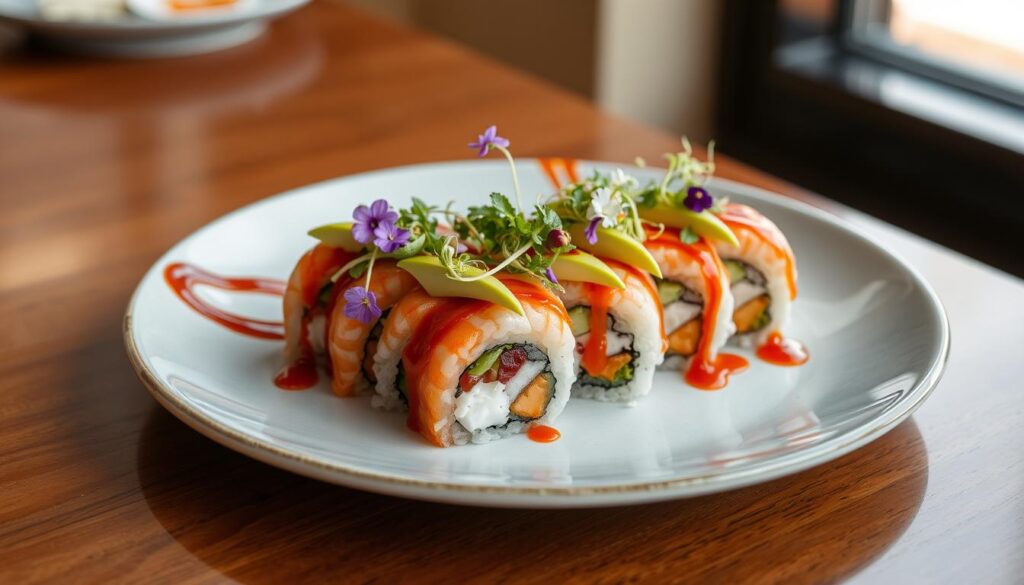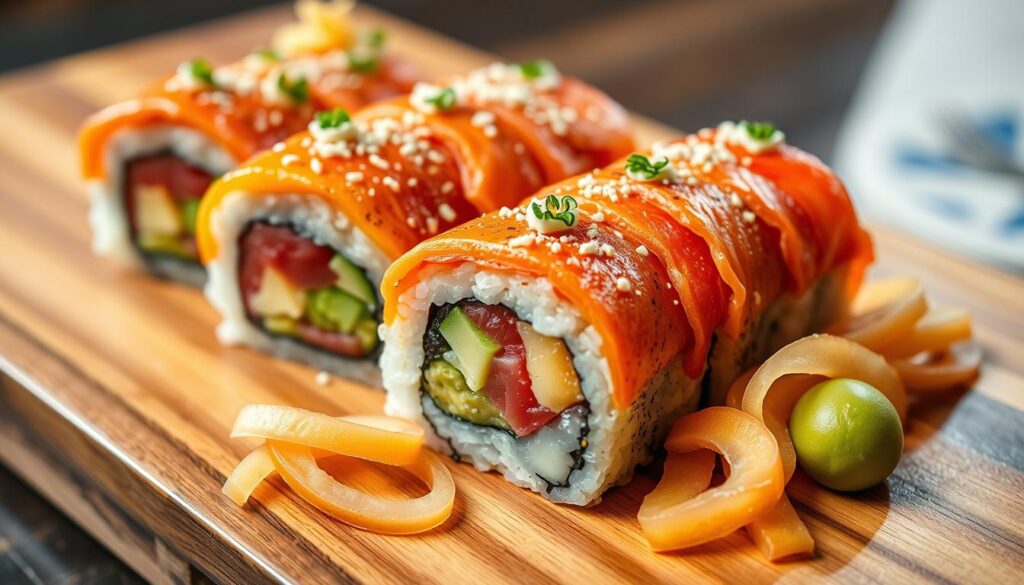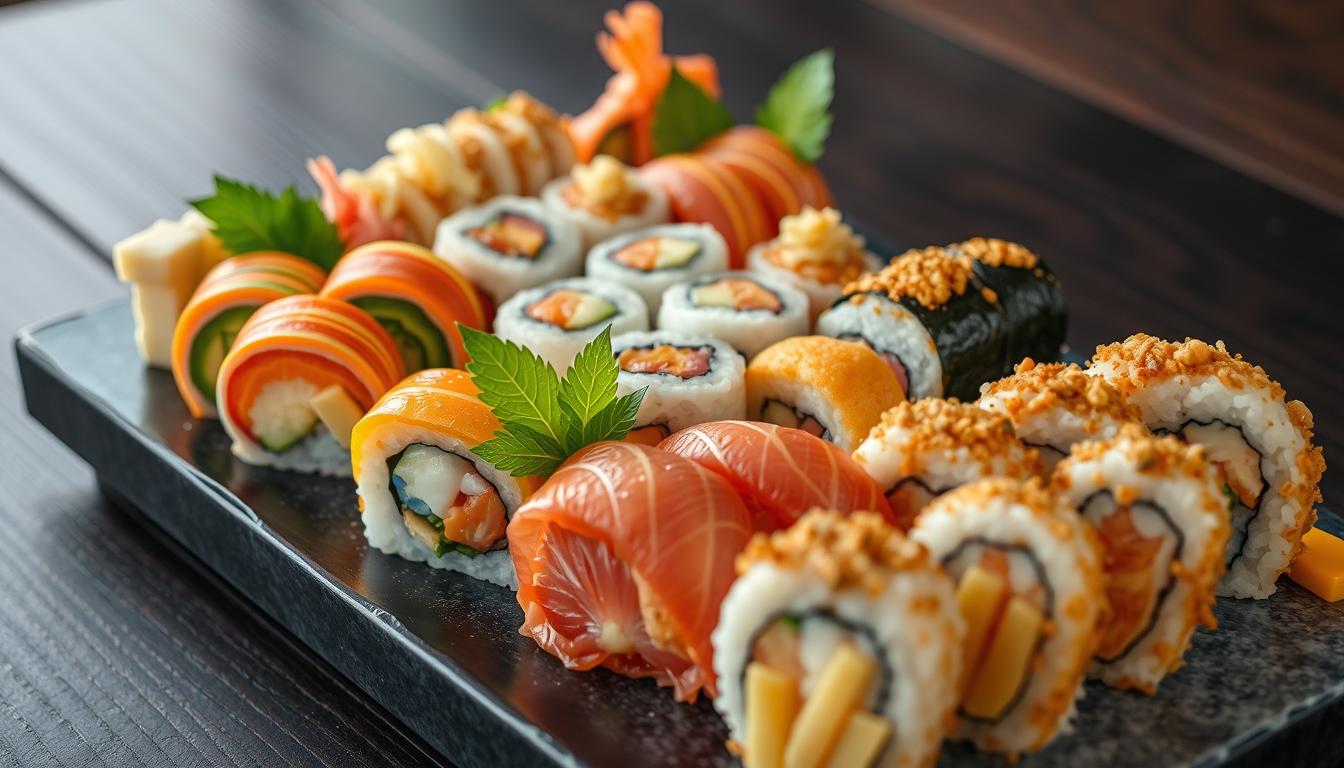Dive into the vibrant world of Japanese cuisine with the best sushi rolls. They will change how you see food. Sushi has become a global hit, blending flavors, textures, and art that excites everyone.
Whether you’re new to sushi or love it, this guide will take you on a tasty trip. You’ll find everything from classic California rolls to new fusion rolls. It’s a journey through the amazing world of sushi.
Sushi is more than food; it’s a cultural experience. Every bite is a mix of precision, creativity, and flavor. Our list of top sushi rolls will inspire you to try new things and maybe even make sushi at home.
Table of Contents
Understanding Sushi Fundamentals
Getting into sushi is more than just wanting to eat it. It’s about knowing and doing things right. In Japan, sushi chefs spend years, even decades, improving their skills. They show how each sushi platter is a work of art.
To make real sushi, you need to know about its main parts. These are top-notch ingredients and how to prepare them.
What Makes Authentic Sushi Rice
Sushi rice is key to a great sushi roll. The right mix includes:
- 2 cups of sushi rice
- 2 cups of water
- 1/4 cup rice vinegar
- 2 tablespoons sugar
- 1/2 teaspoon salt
“Rice is the heart of sushi—get it right, and everything else follows.” – Sushi Master
Essential Sushi-Making Tools
You’ll need special tools to turn ingredients into sushi art:
- Bamboo rolling mat
- Sharp knife
- Plastic wrap
- Large mixing bowl
- Rice paddle
Basic Rolling Techniques
Learning to roll sushi takes time. Begin by placing nori on your mat, then spread rice, and add your fillings. Roll it gently but firmly to make a tight roll.
Pro tip: Wet your hands with water to prevent rice from sticking during preparation.
Classic California Roll: The Perfect Starting Point
If you’re new to sushi, the California roll is a great place to start. It has made Japanese food popular in the U.S. for many people.
The California roll has three main ingredients. They make a tasty mix:
- Imitation crab meat
- Fresh avocado
- Crisp cucumber
This role stands out because it’s very flexible. You can have it as a maki roll or a uramaki roll.
“The California roll transformed sushi from an exotic delicacy to an everyday favorite” – Sushi Experts
Looking at the nutrition of a California roll, it’s a good choice for a meal:
| Nutritional Value | Amount per Serving |
|---|---|
| Calories | 176 kcal |
| Protein | 13 g |
| Total Fat | 8 g |
| Carbohydrates | 11 g |
When making your California roll, remember it makes 8 pieces. A tip: use 2/3 cup of sushi rice and mix in 2 tablespoons of sushi vinegar. This will give you the right texture and taste.
Spicy Tuna Roll: A Flavor Explosion
The spicy tuna roll is a hit among sushi lovers. It mixes bold flavors with skill, making it a top choice.
Making a great spicy tuna roll needs focus and the right ingredients. The right mix turns a simple roll into a flavor explosion.
Selecting the Right Tuna
Your spicy tuna roll begins with top-quality tuna. Look for:
- Fresh, bright red color
- Firm texture without discoloration
- Sushi-grade certification
- Sourced from reputable seafood suppliers
Mastering the Spicy Mayo Sauce
The sauce is key to a great spicy tuna roll. Your spicy mayo should be creamy but spicy.
| Ingredient | Quantity | Purpose |
|---|---|---|
| Mayonnaise | 1/4 cup | Creamy base |
| Sriracha | 1-2 tbsp | Spicy kick |
| Sesame oil | 1 tsp | Depth of flavor |
Rolling and Presentation Tips
Make your spicy tuna roll stand out with these tips:
- Use a sharp knife for clean cuts
- Keep hands slightly wet while rolling
- Apply gentle, consistent pressure
- Garnish with sesame seeds or green onions
“A great spicy tuna roll is an art form that combines precision, flavor, and visual appeal.” – Sushi Master
A typical spicy tuna roll has about 692 kcal per serving. It has 21g of protein and healthy fats, making it tasty and good for you.
Dragon Roll: An Art of Presentation

The Dragon Roll is a standout among sushi rolls. It turns eating into a feast for the eyes. This dish combines art and flavor, making it a highlight on any sushi platter.
Making a Dragon Roll needs skill and creativity. It usually has:
- Crispy shrimp tempura
- Creamy avocado
- Fresh cucumber
- Rich eel sauce
Its presentation is what makes it unique. Chefs place thin avocado slices on top, creating dragon scales. The result is a roll that looks almost too beautiful to eat.
“A great Dragon Roll is not just food, it’s edible art.” – Professional Sushi Chef
When making this roll, interesting facts come up:
| Preparation Detail | Specific Measurement |
|---|---|
| Roll Pieces | 6-10 pieces (8 most common) |
| Avocado Slices | 1-2 millimeters thick |
| Customer Preference | 55% rank as favorite roll |
| Price Range | $10-$18 |
Learning to make a Dragon Roll takes time. But the end result is worth it. Your guests will be amazed by its taste and look.
Essential Sushi Recipes for Beginners
Starting with sushi recipes might seem hard, but it’s easier than you think. You’ll need simple ingredients to make tasty homemade rolls. This makes it fun and easy to get started.
Step-by-Step Rolling Instructions
Learning to roll sushi takes time and effort. Here’s how to do it right:
- Prepare your bamboo mat and cover it with plastic wrap
- Spread sushi rice evenly on the nori sheet
- Add sushi ingredients sparingly in a thin line
- Use the mat to roll firmly but gently
- Seal the roll with a light press of moisture
Common Mistakes to Avoid
New sushi makers often face a few common issues:
- Overfilling the roll, which makes closing difficult
- Using too much rice creates an unbalanced texture
- Not wetting the knife between cuts for clean slices
- Selecting low-quality fish for raw preparations
Sauce Pairing Guide
| Sushi Type | Recommended Sauce | Flavor Profile |
|---|---|---|
| California Roll | Spicy Mayo | Creamy, Slightly Spicy |
| Tuna Roll | Soy Sauce | Umami, Salty |
| Vegetable Roll | Ponzu | Citrusy, Light |
Pro tip: Always use fresh ingredients and practice your technique to improve your sushi-making skills!
Philadelphia Roll: East Meets West
The Philadelphia roll is a mix of Japanese sushi and American flavors. It started in the 1980s and ’90s. It changed how sushi places mix new tastes.
This role combines ingredients in a unique way. It usually has:
- Smoked salmon
- Cream cheese
- Cucumber
- Nori (seaweed wrap)
- Sushi rice
Chiefs aim to mix creamy and fresh parts. The cream cheese adds a rich feel. The smoked salmon is smooth. The cucumber adds a nice crunch.
“The Philadelphia roll proves that culinary innovation knows no boundaries”
This roll is great for sushi newbies. It uses familiar ingredients. Yet, it keeps the real sushi-making ways.
| Ingredient | Quantity for 8 Rolls |
|---|---|
| Sushi Rice | 2 cups uncooked |
| Smoked Salmon | 6 ounces |
| Cream Cheese | 8 ounces |
| Nori Sheets | 4-5 sheets |
Tip: Make sure the cream cheese is soft. Slice the smoked salmon thinly. This helps roll smoothly and taste better.
Traditional vs Modern Sushi Variations
Sushi has changed a lot since it came to America. It started as a traditional Japanese dish. Now, it’s a mix of old and new, with flavors from around the world.
Evolution of Sushi in America
The story of sushi in America is really interesting. Old Japanese ways met new local tastes. This mix created unique flavors that everyone loves.
- The California Roll started the mix of East and West
- Local foods changed how sushi was made
- New flavors made sushi even more creative
Popular Fusion Combinations
Today’s sushi chefs are like artists. They mix Japanese and American tastes. Now, you can find sushi with cream cheese, jalapeños, and avocado. These are new to traditional Japanese sushi.
“Sushi is no longer just a Japanese dish, but a global culinary experience” – Anonymous Sushi Chef
Regional Influences
Every part of the United States has its own sushi style. On the West Coast, you’ll find rolls with lots of seafood. In the South, sushi is spicier and bolder.
| Region | Unique Sushi Characteristics |
|---|---|
| West Coast | Fresh seafood, lighter rolls |
| Southwest | Spicy ingredients, jalapeño-infused rolls |
| Northeast | Sophisticated, upscale sushi presentations |
The story of sushi shows how tradition and new ideas come together in America’s food culture.
Rainbow Roll: A Colorful Experience

The Rainbow Roll is a standout among the best sushi rolls. It turns a simple sushi platter into a feast for the eyes and taste buds. This dish is a true masterpiece.
This role is a celebration of color and taste. It starts with crab, avocado, and cucumber. Then, it’s topped with different fish to create a rainbow effect.
“A Rainbow Roll is like an edible painting on your plate” – Sushi Chef Recommendation
Ingredients for the Perfect Rainbow Roll
- Sushi rice (1½ cups short-grain Japanese rice)
- Nori seaweed sheets
- Crab meat
- Fresh avocado
- Cucumber
- Assorted fish toppings
Nutritional Highlights
| Nutritional Value | Per Roll |
|---|---|
| Calories | 151 kcal |
| Carbohydrates | 26 g |
| Protein | 4 g |
| Total Fat | 4 g |
Choose fish with different colors for your Rainbow Roll. Salmon, tuna, yellowtail, and white fish are great for the rainbow look. Spread sushi rice over two-thirds of your nori sheet for the right balance.
For a perfect sushi platter, use a wet knife to cut. This prevents sticking and keeps your slices looking great. Each Rainbow Roll makes 6 beautiful pieces that will wow everyone.
Conclusion: Mastering the Art of Sushi Making
Your journey into sushi recipes has shown the depth and creativity of Japanese cuisine. Making sushi is not just cooking—it’s an art that needs patience, precision, and passion. With practice, you’ll learn to turn simple ingredients into beautiful, tasty rolls, just like in restaurants.
The sushi market is growing worldwide, showing how much people love this craft. Even home cooks can make impressive sushi quickly. Each roll is a chance to try new flavors, textures, and ways of presenting, all your own.
Keep learning about sushi recipes, focusing on quality ingredients, rice, and rolling techniques. Japanese cuisine is all about balance and respect for each part. Start with easy rolls like California or Philadelphia, then try more complex ones. Your skills will grow, making sushi a fun adventure.
Enjoy the learning, stay curious, and dive into the traditions of sushi making. Your kitchen is now a place to create delicious, artistic meals that connect you to a long-standing culinary tradition.

